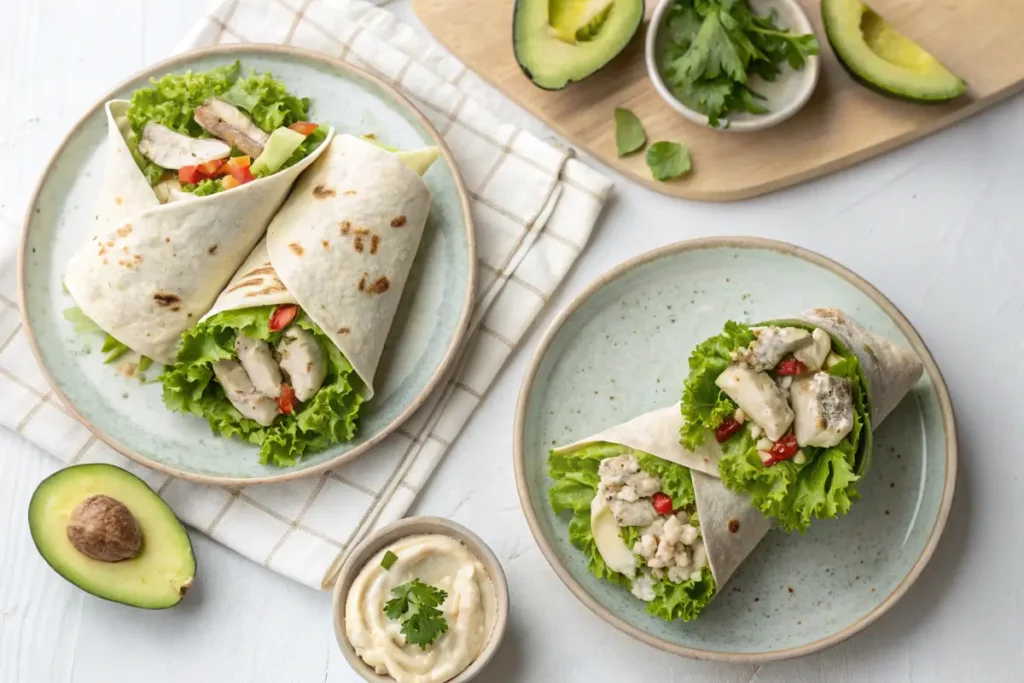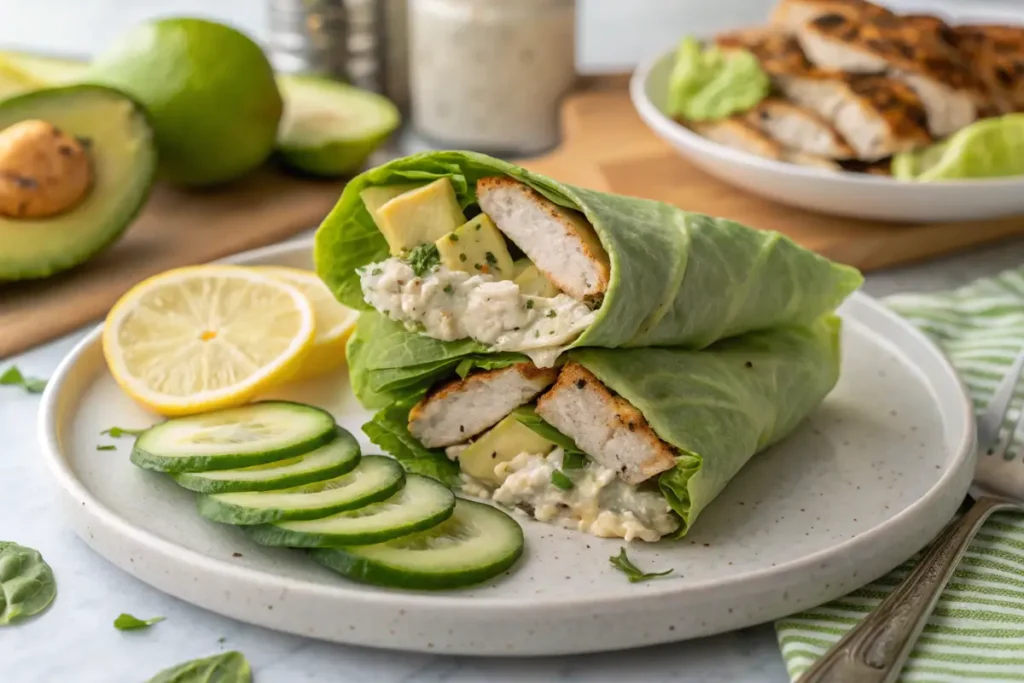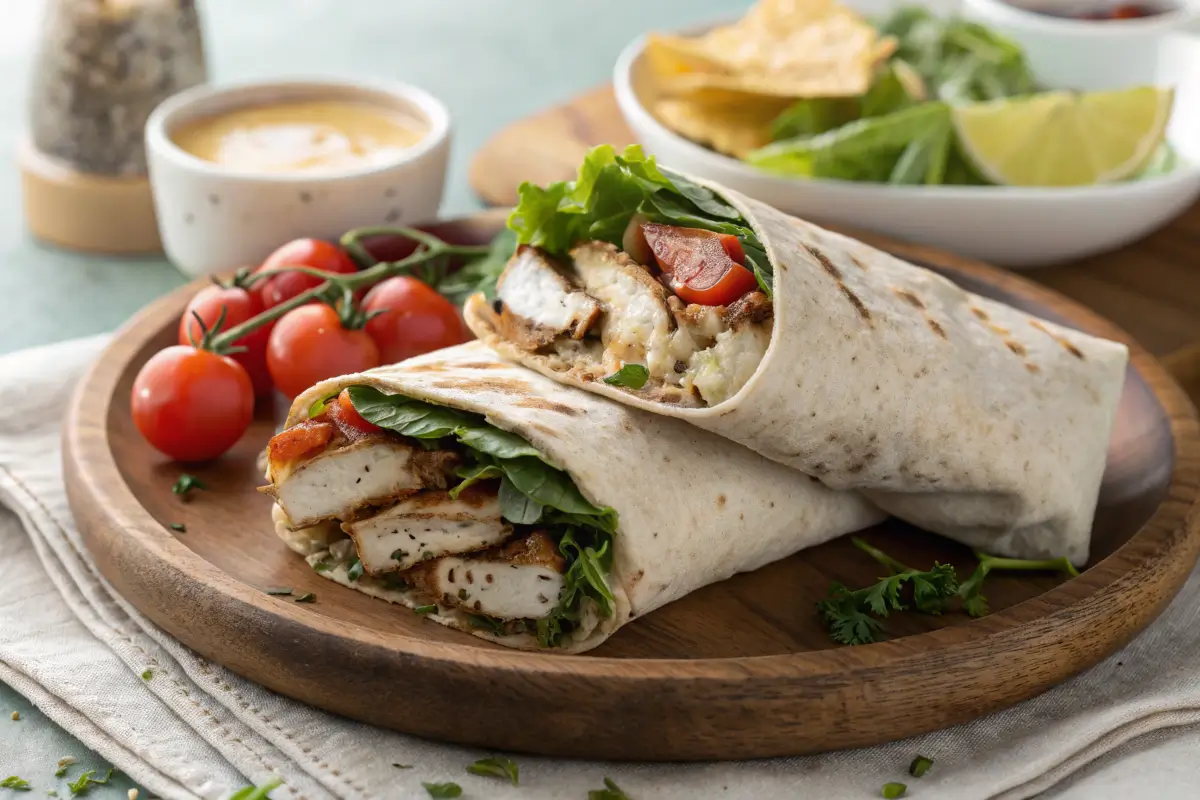Table of Contents
How Many Calories in a Chicken Salad Wrap?
Chicken salad wraps are a delicious, versatile meal, but how many calories in a chicken salad wrap? The answer depends on ingredients, portion size, and preparation methods. This guide will break down the calorie count, nutritional value, and healthy variations to help you make informed choices.
Introduction to Chicken Salad Wraps
What Is a Chicken Salad Wrap?
A chicken salad wrap is a simple yet satisfying dish that combines shredded or diced chicken, fresh vegetables, and creamy dressing, all rolled up in a tortilla or flatbread. This portable meal is popular for lunches, picnics, or quick dinners. Whether served cold or slightly warmed, it’s a flavorful option enjoyed by people of all ages.
Why Is It Popular?
The popularity of chicken salad wraps stems from their versatility and convenience. They can be tailored to fit various dietary preferences, from high-protein diets to low-carb meal plans. Chicken wraps are also easy to prepare and pack for on-the-go meals, making them a favorite for busy lifestyles.
Importance of Knowing Caloric Content
Understanding the caloric content of a chicken salad wrap is essential for anyone mindful of their diet. Ingredients like mayonnaise, cheese, or high-calorie dressings can sneak in extra calories, turning a seemingly healthy wrap into a calorie-heavy indulgence. By learning the nutritional breakdown, you can make informed choices to enjoy this dish without compromising your dietary goals.
How Many Calories in a Chicken Salad Wrap? The Essentials You Need to Know
How Many Calories in a Chicken Salad Wrap on Average?
So, how many calories are in a chicken salad wrap? On average, a standard wrap contains anywhere from 300 to 500 calories. The calorie count can vary widely based on ingredients and portion sizes. For instance, a basic wrap made with whole-grain tortillas, grilled chicken, and a light dressing will be on the lower end. On the other hand, wraps loaded with mayonnaise-based dressings, cheese, or high-carb tortillas quickly tip the scale.
What Affects the Calories in a Chicken Salad Wrap?
The calorie count of a chicken salad wrap often depends on its main components:
- Chicken: Skinless, grilled chicken is a low-fat, high-protein option contributing roughly 120 calories per 3 ounces.
- Tortilla or Wrap: Flour tortillas typically add about 150–200 calories, while whole-wheat or low-carb options can be as low as 70 calories.
- Dressing: Mayonnaise-based dressings pack in about 100 calories per tablespoon, while Greek yogurt or mustard reduces this significantly.
- Add-ons: Ingredients like cheese (50–100 calories) or avocado (80 calories) can provide healthy fats but increase the calorie load.
Factors That Influence Caloric Content
Several factors can influence the overall caloric value:
- Cooking Method: Grilled chicken is leaner than fried.
- Portion Sizes: Larger tortillas or extra fillings result in more calories.
- Type of Wrap: Gluten-free and low-carb wraps often have fewer calories than traditional ones.
To better manage your calorie intake, try measuring ingredients and opting for lighter alternatives when assembling your wrap. For more on keeping wraps fresh, check out this helpful guide to preventing soggy wraps.
Comparing Different Recipes
Classic Chicken Salad Wraps
The traditional chicken salad wrap uses diced chicken, mayonnaise, celery, and lettuce wrapped in a soft tortilla. While simple, it tends to be calorie-rich due to the dressing. A typical serving might contain 400–450 calories, with most coming from mayonnaise and the tortilla.
Healthy Alternatives to Reduce Calories in Chicken Salad Wraps

For a lighter twist, you can swap high-calorie ingredients for healthier options:
- Low-Fat Dressing: Use Greek yogurt instead of mayo.
- Lean Protein: Opt for grilled chicken breast over rotisserie.
- Tortilla Substitutes: Consider lettuce wraps or whole-grain tortillas.
With these changes, you can enjoy a wrap for under 300 calories, while still keeping it delicious and satisfying.
High-Calorie Options and Add-ons
Fancy wraps with extras like cheese, bacon, or ranch dressing can push the calorie count past 600 calories. While indulgent, these are best saved for occasional treats or shared portions.
When choosing recipes, it’s all about balance. You can reduce excess calories by moderating portion sizes and making thoughtful ingredient swaps.
Nutritional Value Beyond Calories
Protein Content in Chicken Salad Wraps
Chicken salad wraps are a great source of protein, which is essential for building and repairing tissues. A single wrap can offer anywhere from 20 to 30 grams of protein, depending on the amount and type of chicken used. Grilled or baked chicken provides lean protein without excess fat, making it a healthier choice.
Fat and Carb Distribution
The fat content in a chicken salad wrap varies based on ingredients. While mayonnaise or cheese can add unhealthy fats, incorporating avocado or olive oil delivers heart-healthy alternatives. On average, a wrap may contain 10 to 15 grams of fat. For carbohydrates, flour tortillas contribute most of the 30 to 40 grams of carbs, which can be lowered by using whole-grain or low-carb wraps.
Micronutrients and Fiber
A chicken salad wrap can also be a good source of vitamins and minerals, especially if packed with fresh vegetables like lettuce, tomatoes, or spinach. These ingredients add fiber, vitamin C, and potassium, improving overall nutritional balance. Substituting white flour tortillas for whole-grain options boosts fiber content, aiding digestion and keeping you full longer.
For more recipe inspiration, explore our tips for rolling perfect wraps to ensure you enjoy every bite.
Popular Restaurant Options
Fast Food Chicken Salad Wraps
Fast food chains often offer chicken salad wraps, but they tend to be higher in calories due to larger portions and rich dressings. For example, a chicken wrap from a fast food restaurant can have 500 to 700 calories, primarily due to fried chicken and creamy sauces. Checking nutritional information ahead of time can help you make smarter choices.
Gourmet and Homemade Wraps
Gourmet wraps made at specialty delis or restaurants might boast unique flavors like spicy aioli or artisan tortillas, but these extras can add significant calories. On the flip side, homemade wraps let you control every ingredient. By using lean chicken, low-fat dressings, and nutrient-rich veggies, you can create a wrap with less than 400 calories.
Chain Restaurant Nutritional Analysis
Many chain restaurants provide detailed calorie counts for their menu items. When dining out, look for grilled or roasted chicken options and request sauces or dressings on the side. This small adjustment can save hundreds of calories without compromising flavor.
For more delicious recipe ideas and cooking inspiration, check out our culinary journey articles for simple, tasty meals.
How to Customize for Your Diet
Low-Carb Variations
If you’re counting calories, you may wonder, how many calories in a chicken salad wrap if I make it healthier? Using a lettuce wrap instead of a tortilla can reduce 150–200 calories, while swapping mayo for mustard or Greek yogurt saves 50–100 calories per serving.
Keto and Paleo-Friendly Options
For those on a keto or paleo diet, customizing your wrap is simple. Use grilled chicken for a high-protein base and add healthy fats like avocado or olive oil. Skip high-carb dressings and opt for a mix of mustard or Greek yogurt seasoned with herbs. A keto chicken salad wrap may have only 5–7 grams of carbs, making it a satisfying and compliant meal.

Vegetarian and Vegan Adaptations
You don’t need chicken to enjoy a flavorful wrap! Replace the chicken with plant-based proteins like chickpeas or tofu for a vegetarian option. For a vegan twist, use hummus or cashew-based dressings instead of mayo, and load up on veggies like shredded carrots, bell peppers, or cucumbers. These adaptations are not just nutrient-dense but also keep calories low while offering vibrant flavors.
For a guide on keeping wraps fresh and appetizing, check out how to keep wraps from getting soggy.
Frequently Asked Questions (FAQs)
What is the healthiest way to prepare a chicken salad wrap?
The healthiest version of a chicken salad wrap uses grilled chicken, whole-grain tortillas, and light dressings like Greek yogurt or vinaigrette. Adding fresh vegetables like lettuce, tomatoes, and cucumbers keeps the calorie count low while boosting fiber and vitamins.
Can chicken salad wraps be part of a weight-loss diet?
Absolutely! The key is portion control and choosing ingredients wisely. A wrap with fewer than 400 calories can be filling and satisfying, helping you stick to your weight-loss goals.
How does the wrap type affect the calorie count?
Wraps made with whole-grain or low-carb tortillas typically contain fewer calories and more fiber than traditional white flour tortillas. For instance, switching to a lettuce wrap can cut 150–200 calories from your meal.
Are chicken salad wraps high in protein?
Yes, chicken salad wraps are naturally high in protein, with about 20–30 grams per serving, depending on the amount and type of chicken used. Protein is essential for building muscle and keeping you full longer.
Tips for Making the Perfect Chicken Salad Wrap
Choosing the Right Ingredients
Making the perfect chicken salad wrap starts with choosing fresh, high-quality ingredients. Opt for grilled or baked chicken, as these are lower in fat compared to fried options. Use a mix of crunchy vegetables like lettuce, spinach, or bell peppers to add texture and nutrients. Additionally, whole-grain tortillas or lettuce wraps keep the calorie count lower, which is important if you’re asking, how many calories are in a chicken salad wrap?
Balancing Flavor and Nutrition
Striking the right balance between flavor and nutrition is key. While creamy dressings like mayonnaise add richness, using Greek yogurt or avocado as a base can cut calories and provide healthy fats. Don’t forget to season your chicken with herbs and spices for an extra burst of flavor without adding unnecessary calories. Experiment with additions like fresh dill, cilantro, or lemon juice for a refreshing twist.
Practical Assembly Tips
To assemble your wrap without making a mess, layer the ingredients thoughtfully. Start with a base of greens, followed by the chicken salad, and then add any extras like shredded carrots or cheese. Keep the fillings centered to make rolling easier. For a tight wrap, fold the sides inward before rolling from one end to the other.
Final Thoughts and Conclusion
Recap of Key Points
Chicken salad wraps are not only tasty but also versatile, making them suitable for various dietary needs. Whether you’re watching your calories or looking for a protein-packed meal, you can customize a wrap to fit your goals. On average, the answer to how many calories in a chicken salad wrap? is between 300 and 500 calories, but this depends largely on the ingredients and portion sizes.
Why They’re a Great Choice
Chicken salad wraps are portable, easy to make, and packed with flavor. With endless options for customization, they work well for quick lunches, meal prep, or even dinner. By making smart swaps like using whole-grain wraps or lighter dressings, you can enjoy a healthy meal without sacrificing taste.
For more creative meal ideas, explore our collection of recipes at Tester Recipes, where delicious and nutritious options await.

